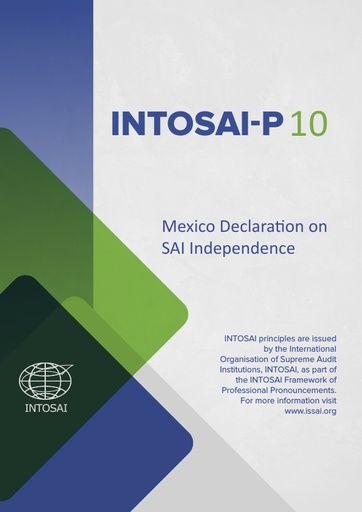SAI INDEPENDENCE refers to the conditions a Supreme Audit Institution needs to fulfill its mandate and operate effectively.
SAI Independence, however, is not a simple construct, and in fact encapulates two distinct elements. First, there is "de jure independence", which is the independent conditions that should be encapsulated in the SAI's legal framework.
Understanding SAI Independence
The INTOSAI Lima and Mexico Declarations
INTOSAI has long recognized the importance of the independence of SAIs, and has been instrumental in defining and mainstreaming the concept of SAI independence. The principles of SAI independence have been laid down through the adoption of two key documents: The INTOSAI Lima and Mexico Declarations.
The Lima Declaration, endorsed in 1977, sets out the principles of independence of public sector auditing in methodological and professional terms. The Declaration was the first INTOSAI document to comprehensively set out the importance of SAI independence, by reminding
INTOSAI members and their stakeholders that SAIs can only be objective, credible and effective if they are independent from the audited entity and are protected from outside influence.
The principles laid down in sections 5 to 7 of the Declaration can be summarised as follows:
- Organisational independence is to ensure independence of SAI members (acting free from instructions; no possibility of arbitrary dismissal), and supreme authority of the Head of SAI in all staff-related matters, as well as non-interference on auditors by external sources.
- Functional independence implies that the audit powers of the SAI are laid down in the Constitution, at least in general terms; the SAI is free to set up its own audit programme, and the SAI is free in drafting reports intended for publication.
- Financial independence implies that SAIs can directly apply for the required funding to the body adopting the state budget (Parliament), as necessary, and SAIs can freely dispose of the appropriated budget during the financial year.
Following an increased recognition of the challenges faced by SAI, INTOSAI issued a second key document in 2007, known as the Mexico Declaration. The Mexico Declaration which is now known as INTOSAI- P10 expands on the principles set by the Lima Declaration and highlights eight conditions, known as the eight pillars of independence, which constitutes the benchmark against which the Independence of an SAI can be compared.
The Mexico Declaration and the Eight Pillars of SAI Independence
The Mexico Declaration of 2007 contains the eight principles of SAI Independence:
- The existence of an appropriate and effective constitutional/statutory/legal framework and of de facto application provisions of this framework.
- The independence of Head of SAIs and members (of collegial institutions), including security of tenure and legal immunity in the normal discharge of their duties.
- A sufficiently broad mandate and full discretion, in the discharge of SAI functions.
- Unrestricted access to information.
- The right and obligation of SAIs to report on their work.
- The freedom to decide the content and timing of audit reports, and to publish and disseminate them.
- The existence of effective follow-up mechanisms on the SAI’s recommendations.
- Financial and managerial/administrative autonomy, and the availability of appropriate human, material, and monetary resources.

Click on the individual pillars to explore each principle in more detail
